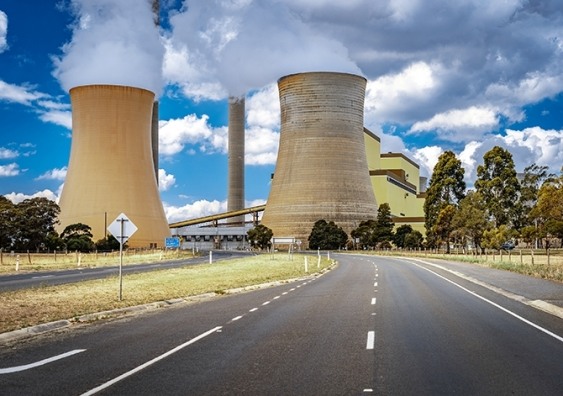Jun 11 2020
A novel technology developed by UNSW Sydney chemical engineers changes dangerous emissions of carbon dioxide (CO2) into chemical building blocks. These chemical building blocks can be used to make valuable industrial products such as plastics and fuel.
 The technology to convert carbon dioxide into industrial precursor chemicals could be retrofitted to coal-fired power plants. Image Credit: Shutterstock.
The technology to convert carbon dioxide into industrial precursor chemicals could be retrofitted to coal-fired power plants. Image Credit: Shutterstock.
If the process is implemented on a commercial scale, it may give some breathing space to the world, as it shifts towards a green economy.
In a study published recently in the Advanced Energy Materials journal, Dr Rahman Daiyan and Dr Emma Lovell, both from the School of Chemical Engineering in UNSW Sydney, have described a new method to produce nanoparticles that support the conversion of unwanted CO2 into valuable industrial components.
Open Flame
Scientia Professor Rose Amal guided the scientists, who conducted their study in the Particles and Catalysis Research Laboratory. The researchers demonstrated that nanoparticles can be created by producing zinc oxide at intense temperatures through a technique known as flame spray pyrolysis (FSP).
These nanoparticles serve as the catalyst for converting CO2 into “syngas”—a combination of carbon monoxide and hydrogen employed in the production of industrial products.
According to the team, this technique is more economical and more scalable to suit the needs of heavy industries than what is currently available.
We used an open flame, which burns at 2000 degrees, to create nanoparticles of zinc oxide that can then be used to convert CO2, using electricity, into syngas. Syngas is often considered the chemical equivalent of Lego because the two building blocks—hydrogen and carbon monoxide—can be used in different ratios to make things like synthetic diesel, methanol, alcohol or plastics, which are very important industrial precursors.
Dr Emma Lovell, School of Chemical Engineering, UNSW Sydney
Dr Lovell continued, “So essentially what we’re doing is converting CO2 into these precursors that can be used to make all these vital industrial chemicals.”
Closing the Loop
In an industrial environment, an electrolyzer composed of zinc oxide particles produced by the FSP technique can probably be used to transform the unwanted CO2 into useful permutations of syngas, stated Dr Daiyan.
Waste CO2 from say, a power plant or cement factory, can be passed through this electrolyser, and inside we have our flame-sprayed zinc oxide material in the form of an electrode. When we pass the waste CO2 in, it is processed using electricity and is released from an outlet as syngas in a mix of CO and hydrogen.
Dr Rahman Daiyan, School of Chemical Engineering, UNSW Sydney
According to the researchers, they are essentially closing the carbon loop existing in industrial processes that generate toxic greenhouse gases. If slight changes are made to the way the nanoparticles are ignited by the FSP method, the subsequent mix of the syngas building blocks generated by the conversion of CO2 can be clearly determined.
“At the moment you generate syngas by using natural gas—so from fossil fuels,” added Dr Daiyan. “But we’re using waste carbon dioxide and then converting it to syngas in a ratio depending on which industry you want to use it in.”
For instance, a one-to-one ratio between hydrogen and carbon monoxide is conducive to syngas that can be utilized as fuel. However, a ratio of one part hydrogen and four parts carbon monoxide is appropriate for producing plastics, added Dr Daiyan.
Cheap and Accessible
While selecting zinc oxide as their catalyst, the scientists have made sure that their solution continues to present a cheaper option to what has been tried in this space before.
Past attempts have used expensive materials such as palladium, but this is the first instance where a very cheap and abundant material, mined locally in Australia, has been successfully applied to the problem of waste carbon dioxide conversion.
Dr Rahman Daiyan, School of Chemical Engineering, UNSW Sydney
This method is also appealing because it enables the use of FSP flame system to produce and manage these useful materials, added Dr Lovell.
“It means it can be used industrially, it can be scaled, it’s super quick to make the materials and very effective. We don’t need to worry about complicated synthesis techniques that use really expensive metals and precursors—we can burn it and in 10 minutes have these particles ready to go. And by controlling how we burn it, we can control those ratios of desired syngas building blocks,” she further stated.
Scaling up
While Dr Daiyan and Dr Lovell have already developed an electrolyzer that has been validated with unwanted CO2 gas containing contaminants, upgrading the technology up to the point where it could transform the entire unwanted CO2 produced by a power plant is still a long way to go.
“The idea is that we can take a point source of CO2, such as a coal fired power plant, a gas power plant, or even a natural gas mine where you liberate a huge amount of pure CO2 and we can essentially retrofit this technology at the back end of these plants. Then you could capture that produced CO2 and convert it into something that is hugely valuable to industry,” concluded Dr Lovell.
The next plan of the researchers will be to test their nanomaterials in a flue gas environment to make sure they are resistant to the aggressive conditions as well as other chemicals present in industrial waste gas.
Journal Reference:
Daiyan, R., et al. (2020) Uncovering Atomic-Scale Stability and Reactivity in Engineered Zinc Oxide Electrocatalysts for Controllable Syngas Production. Advanced Energy Materials. doi.org/10.1002/aenm.202001381.